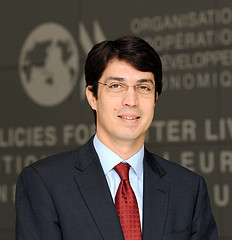 By Luiz de MelloMany countries across Latin American and the Caribbean have in recent years achieved strong growth in living standards while improving social development and the distribution of income. This is no small feat in a continent that remains one of the most unequal in the world, and is all the more impressive when compared with the recent experience of OECD countries, where income disparities have actually increased over the last 30 years, and growth has been slow since the global crisis.
By Luiz de MelloMany countries across Latin American and the Caribbean have in recent years achieved strong growth in living standards while improving social development and the distribution of income. This is no small feat in a continent that remains one of the most unequal in the world, and is all the more impressive when compared with the recent experience of OECD countries, where income disparities have actually increased over the last 30 years, and growth has been slow since the global crisis.
To help policymakers learn from and build on recent Latin American experiences, the Organization for Economic Cooperation and Development (OECD) and the Economic Commission for Latin America and the Caribbean (ECLAC) invited experts from across the region to a Consultation on Inclusive Growth on November 14th and 15th in Santiago, Chile. We discussed the progress that has been made toward ensuring that the benefits of economic growth are better shared among all Latin Americans.
The discussion has to begin with economic growth, which remains the first step if Latin America is to bridge the large gap in living standards relative to the wealthier OECD countries. Income per capita in the region is today only about one-third of the average in the OECD area, even in the more prosperous countries like Argentina, Brazil, Chile and Mexico. The drivers of growth must also be reconsidered -- Latin American growth has long been based on investment and job creation, given the region's favorable demographics, rather than gains in productivity, which drive performance in advanced economies. Future prosperity in the region will depend largely on the steps countries take to improve their productivity. Our recommendations are well-known, and include chiefly greater investments in human capital and better policies to leverage this investment. Latin America's lopsided distribution of income will add a degree of difficulty to the bid to make growth strong and inclusive. After all, Inclusive Growth is not about pro-growth or distribution-friendly policies; it is about making progress on both fronts. And Inclusive Growth is not about income alone; it is about better outcomes in all aspects of life that matter for people's well-being.
The Latin American countries that have made the most progress toward achieving Inclusive Growth have done so through a mix of external push and home-grown solutions. The global economic environment has helped. Increased world demand for commodities - courtesy of China and other fast-growing emerging-market economies - has driven up the terms of trade, boosting consumption and shifting income to those employed in lower-paid, lower-productivity, often informal jobs. Those at the lower end of the income distribution have benefited greatly.
Many countries have invested heavily in human capital. Easier access to services has created opportunities for those who had not been able to study and acquire marketable competencies. Not only has the supply of skills increased but also demand for those skills. The premia that employers paid for additional years of education used to be among the highest in the world but are now coming down, narrowing the dispersion in labour income.
The best performing countries have also implemented structural reforms. They have opened up their economies to trade and improved the business environment. In doing so, they have unleashed opportunities for investment and entrepreneurship, which is good for productivity and growth, also benefiting those who had hitherto been excluded from economic life.
Public policies have changed. Increasing emphasis has been placed on reaching out to underserved populations and linking social protection strategies to participation in education and health care programs. Multidimensionality -- a key feature of Inclusive Growth -- has come to the fore in the design of social programs. This is the case of Brazil's Bolsa Família program, which directs cash transfers to the country's poorest families, as long as their children attend school and receive preventive health care. Mexico's Oportunidades and other programs throughout the continent share the same philosophy. Short-term income-support objectives are thus combined with the long-term bid to improve human capital and health. It's a solution made in Latin America that the rest of the world is taking notice of.
To ensure these successes continue, countries must put in place necessary reforms to safeguard the progress achieved to date and continue addressing the region's longer-term challenges, notably slow productivity growth, poverty and high inequality. We must all continue working to better understand the policies that deliver both strong growth and greater inclusiveness, and the trade-offs that may need to be addressed in meeting both objectives.
Luiz de Mello is deputy chief of staff to the Secretary-General of the OECD.
